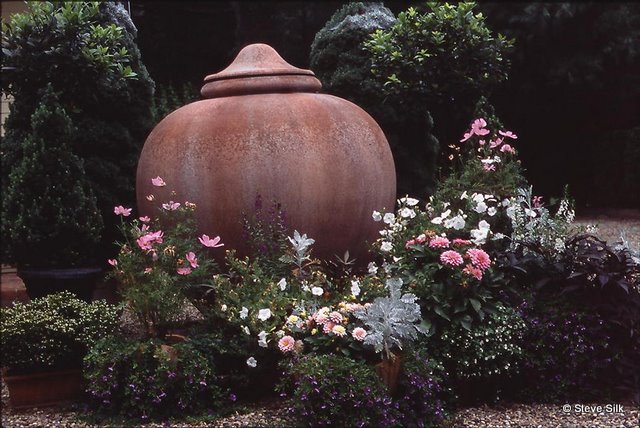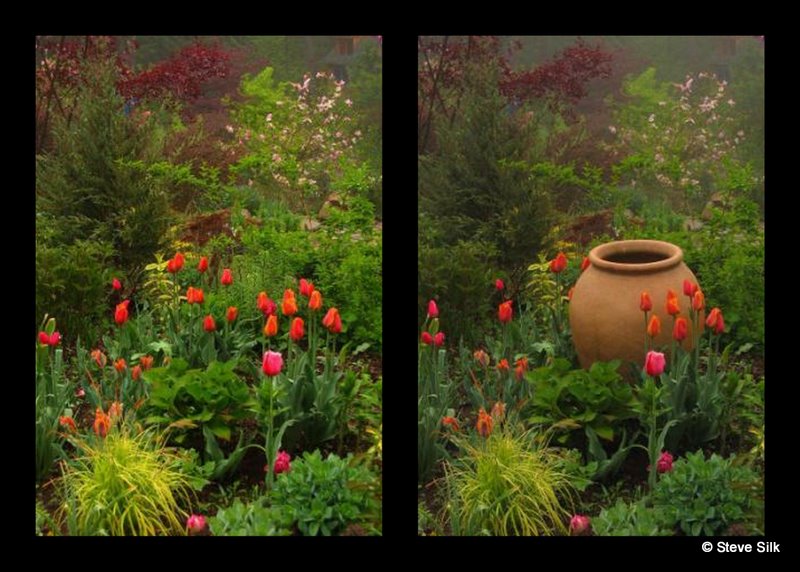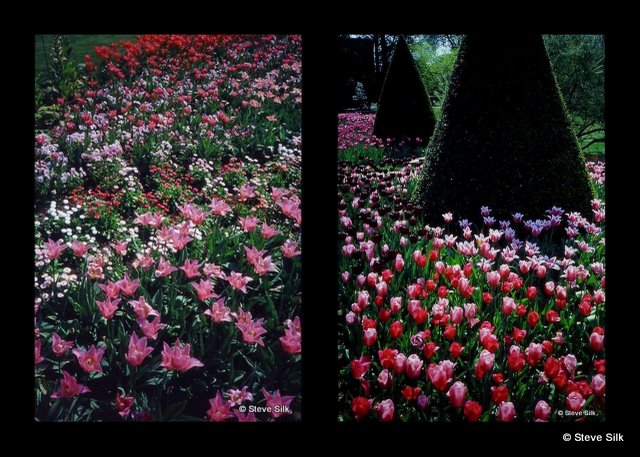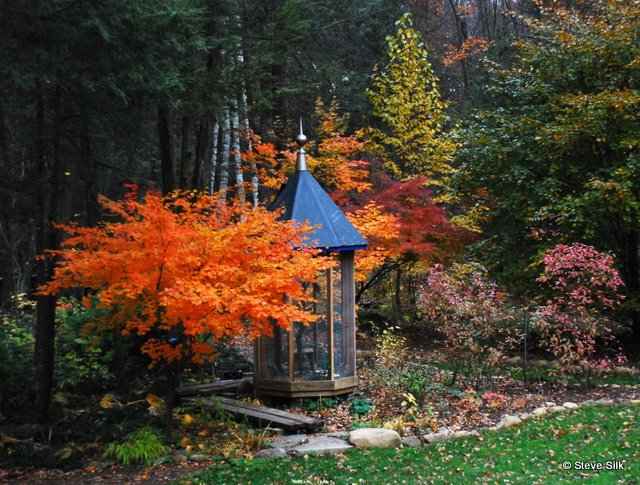
I wish I could say that my garden evolved to its present state thanks to some grand design. But it hasn’t. Oh, we began with a few basic concepts, but for the most part it has grown by equal parts hit-or-miss, with some trowel-and-error thrown in. Its driving force has been, more than anything else, a spirit of invention. That has meant a lot of changes over the years, as once-hazy, half-recognized notions took more solid form. Garden rooms, for example, seemed totally abstract at first–I could understand the idea, but had no clue how to make one. Same with structure. I grasped its value, but was unsure how to proceed–until I tried approaching from it a different angle. That’s when I started trying ONE BIG THING.
Structure, I realized, was all about form–dramatic form, enduring form, contrasting form. It was about architectural shapes, about summoning order from chaos. Unfortunately Iwas working backwards. I had the body–floppy foliage, shrubby stuff, etc–but the body needed bones, or it was all too ethereal, too temporary, too accidental. My first experients were simple ones. Into an attractive but unfocused part of the garden I introduced a little instant structure: a large empty pot.

I realized immediately I was on the right track. For whatever reason, this worked. There was a dynamism between the smooth manufactured shape of the pot and the softer billowy plants that surrounded it. The pot drew attention, providing a center of interest for the once unresolved setting. It was a focal point. It all seemed so simple. All I had to do to provide structure was add ONE BIG THING, or a cluster of things which presented themselves as a single group, or a couple identical things-thereby introducing, in addition, a pleasing element of repetition.

Like this scene at Longwood Gardens. The sea of tulips is handsome enough. But, add the ONE BIG THING of these neatly clipped cones of yew, and–Wowsa!–you’re off to the races.

My ONE BIG THING could be almost anything: a plant, a rock, a building (like this bird cage), an ornament, an empty pot. Sometimes ONE BIG THING led to another.

 I struggled for years with this part of the garden. I loved my empress tree (Paulownia tomentosa), which I cut to the ground every spring to encourage a fast-growing flush of new, gigundo leaves. In a different spot the tree itself might be all the structure you’d need…but, not in this spot. I could never find the right companions for it. Lord knows I tried. Every spring, I was tearing out old plants and putting in new, different ones in hope that it would somehow come together. But it never did. One year, I was hosting a garden tour and needed desperately to address that spot–I wanted it to look attractive, of course, but more importantly, I needed to create a visual stop, a concealing wall, so that as you rounded that area, a new hitherto-hidden scene was suddenly revealed. I plopped in a couple pottted plants, a canna and an Alberta spruce (which may be kind of dowdy but, you know, their tidy conical form makes them a fine structural plant). Which helped, but didn’t quite fill the space. So I tucked in a pot (do you recognize that one?), and…Bingo! It worked. The trouble was, that pot was usually employed elsewhere. But I learned my lesson–I didn’t have to solve the problem with plants, I could just as easily use an object–as long as it was ONE BIG THING, or a cluster that read as a single thing. So, the next season I added the “”Brothers from Another Planet,” who served as sentinels in this part of the garden and whose sturdy, contrasting forms had the necessary oomph to coexist harmoniously with the empress tree. Worked for me and, years later, it still does.
I struggled for years with this part of the garden. I loved my empress tree (Paulownia tomentosa), which I cut to the ground every spring to encourage a fast-growing flush of new, gigundo leaves. In a different spot the tree itself might be all the structure you’d need…but, not in this spot. I could never find the right companions for it. Lord knows I tried. Every spring, I was tearing out old plants and putting in new, different ones in hope that it would somehow come together. But it never did. One year, I was hosting a garden tour and needed desperately to address that spot–I wanted it to look attractive, of course, but more importantly, I needed to create a visual stop, a concealing wall, so that as you rounded that area, a new hitherto-hidden scene was suddenly revealed. I plopped in a couple pottted plants, a canna and an Alberta spruce (which may be kind of dowdy but, you know, their tidy conical form makes them a fine structural plant). Which helped, but didn’t quite fill the space. So I tucked in a pot (do you recognize that one?), and…Bingo! It worked. The trouble was, that pot was usually employed elsewhere. But I learned my lesson–I didn’t have to solve the problem with plants, I could just as easily use an object–as long as it was ONE BIG THING, or a cluster that read as a single thing. So, the next season I added the “”Brothers from Another Planet,” who served as sentinels in this part of the garden and whose sturdy, contrasting forms had the necessary oomph to coexist harmoniously with the empress tree. Worked for me and, years later, it still does.
The beauty of experimenting with the ONE BIG THING idea is its simplicity. It’s no big deal to get, say, a three-foot-tall pot into postition, and you know instantly if it works. If it doesn’t, you can rejigger it until it does. If it’s too small, put it up on something to make it more prominent. Move it left or right. Or, try something else all together. The ONE BIG THING you’re auditioning needn’t be a permanent feature, it’s just a way to see part of the garden differently, a way to experiment, a way to generate ideas. For me, many’s the time such an experiment was the first step in re-imagining a part of the garden that needed something, even when I wasn’t sure quite what. This much I learned: ONE BIG THING opened a conceptual door for me, and my garden is all the better for it.
